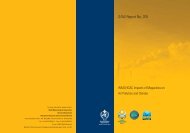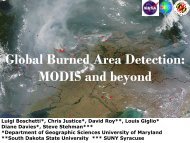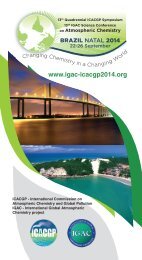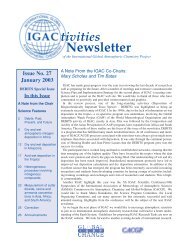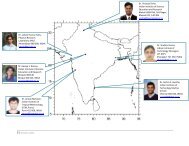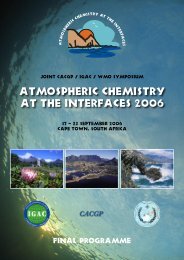Download Abstracts Here - IGAC Project
Download Abstracts Here - IGAC Project
Download Abstracts Here - IGAC Project
Create successful ePaper yourself
Turn your PDF publications into a flip-book with our unique Google optimized e-Paper software.
List of <strong>Abstracts</strong> 71Contact: bumiya@yahoo.comThis study was intended to carry out continuous and simultaneous monitoring of particles and some of thegases in the environment of Gaborone. Measurements of particulate matter were taken using scanningmobility particle sizer (SMPS) capable of measuring particles with diameters from about 7.5 to 280 nm forabout seven months. The concentration of gases CO, CO2, NOx and HC were simultaneously monitoredduring September 2002 and August 2004 using Horiba gas analyzer APMA360, VIA 510, APNA 360 andAPHA 360 respectively. The SMPS and gas analyzers were housed in the Atmospheric Research Laboratorylocated on the first floor of the building of Department of Physics, University of Botswana. Ourmeasurements show that the average concentrations of carbon monoxide varied from 0.16ppm in March2004(summer) to 1.48ppm in July 2004(winter). The monthly average concentration of CO2 was seen tovary between about 302ppm to 450ppm. The concentration of NOx was also seen to increase in July. Theannual concentrations varied between 0.0025 ppm in March to 0.0636 ppm in July. The concentrations oftotal hydrocarbons were seen to rise up to 4.8ppmC at certain times of the day while the averageconcentration was about 1.910ppmC in July (winter). The number concentration of particles vary from 684cm-3 to 1984 cm-3 from summer (January) to winter(July). It was also observed that the concentration ofsmall particles was high during night and low towards morning. It started increasing during the morninghours and evening when traffic starts to build up. Concentration of the gases was also seen to be quite highduring the morning hours and in the evening hours thus showing a good correlation between particleconcentration and gas concentration. These results indicates that particles and gases are mainly contributedby the traffic and biomass used for cooking and warming. Particle concentration of aerosols larger than 0.1µm has its peak during winter months. Some interesting findings will be reported.P-Chemistry Climate.25 ID:4420 15:35New particle formation determines climate forcing of regional SO2 emissionsGraham Mann 1 , Ken Carslaw 1 , Dominick Spracklen 1 , Paul Manktelow 1 , Joonas Merikanto 21 University of Leeds2 University of HelsinkiContact: gmann@env.leeds.ac.ukAnthropogenic emissions of sulphur dioxide exert a cooling influence on the Earth’s climate via enhancedscattering of short-wave radiation and by increased cloud droplet number concentrations (leading to brighter,longer-lived clouds). Recent studies (e.g. Merikanto et al, 2009) have demonstrated the large contribution ofsecondary particle formation from binary H2SO4-H2O nucleation in the free troposphere.In a recent paper (Manktelow et al, 2009), we showed that the potential of a region’s emissions to perturbclimate via enhanced cloud droplet concentrations is related to the lofting of the emissions to regions of theatmosphere where new particle formation can take place. Following air quality legislation, SO2 emissionshave reduced over North America and Europe in the last decades. In this study we use a global aerosolmicrophysics model to calculate the climate forcing that results from regional reductions in SO2 emissionsand compare against equivalent simulations where new particle formation processes are neglected.We demonstrate that in order to adequately characterize aerosol influences in climate through the globaldimming and brightening period, climate models need to resolve microphysical processes like new particleformation, coagulation and condensation that control the global distribution of CCN number concentration.We also demonstrate the skill of the GLOMAP global aerosol microphysics model used in the study byevaluating against a large compilation of observed CCN concentrations from a wide range of locations.iCACGP-<strong>IGAC</strong> 2010 12 July, 2010



